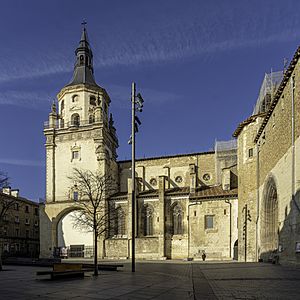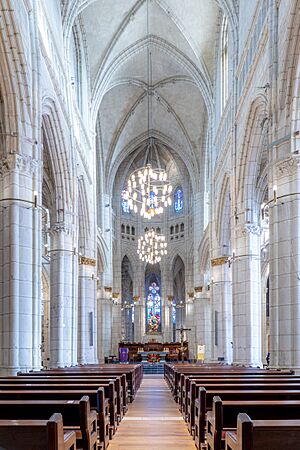Cathedral of Santa María de Vitoria facts for kids
Quick facts for kids Cathedral of Santa María de Vitoria |
|
|---|---|

View from the Plaza de Santa María
|
|
| 42°51′02″N 2°40′21″W / 42.850689°N 2.672431°W | |
| Location | Vitoria-Gasteiz, Álava, Basque Country |
| Country | Spain |
| Denomination | Catholic Church |
| Tradition | Latin Church |
| History | |
| Status | Cathedral, minor basilica |
| Architecture | |
| Style | Gothic |
| Administration | |
| Archdiocese | Archidiocese of Burgos |
| Diocese | Diocese of Vitoria |
The Cathedral of Santa María de Vitoria is a beautiful old church in Vitoria-Gasteiz, Spain. It is built in the Gothic style. This means it has tall arches and big windows. It is a Roman Catholic cathedral.
The cathedral was recognized as an important cultural site in 1931. Later, in 2015, it became part of a World Heritage Site. This site is the famous Camino de Santiago, a historic pilgrimage route.
Contents
History of the Cathedral
The building of the Santa María Cathedral started a long time ago. It began in the late 1200s and continued through the 1300s. It was designed to be like a fortress church. This means it was very strong and looked like a castle. It helped protect the city of Vitoria-Gasteiz.
From Collegiate Church to Cathedral
For many years, from 1496 to 1861, the building was a collegiate church. This is a church that is important but not yet a cathedral. In 1861, it officially became a cathedral.
The church has a special shape called a Latin-cross plan. It has a wide area across the middle called a transept. There is also a round end called an apse, which holds several small chapels.
Beautiful Front Doors
The front of the cathedral has amazing doors. These doors are decorated with many sculptures. The main entrance on the west side has three large doors.
- The middle door is dedicated to the Virgin Mary.
- The door on the left is for San Gil.
- The door on the right shows the Final Judgement and Saint James.
Restoration Project
In 1994, the cathedral had to close to visitors. Part of its roof collapsed, and other parts of the building were damaged. Since then, a big project has been working to fix and restore it. The Santa Maria Cathedral Foundation manages this work. They also offer guided tours so people can see the restoration happening.
More Information
- Tourist info Cathedral of Santa María de Vitoria
See also
 In Spanish: Catedral de Santa María (Vitoria) para niños
In Spanish: Catedral de Santa María (Vitoria) para niños


